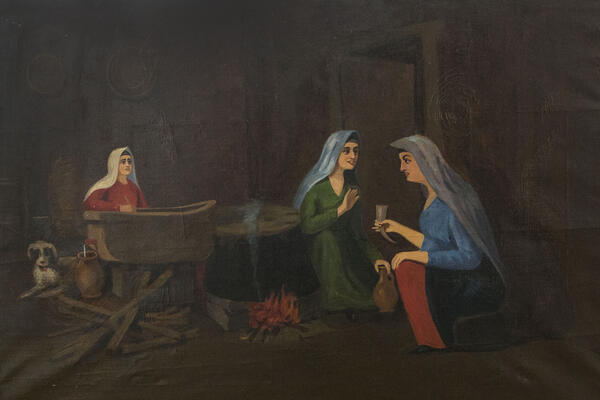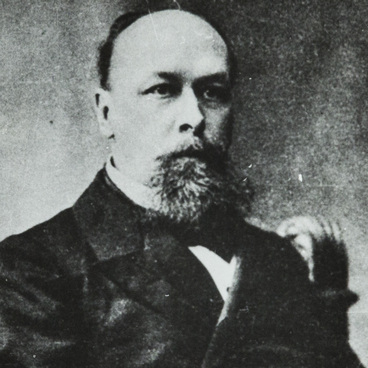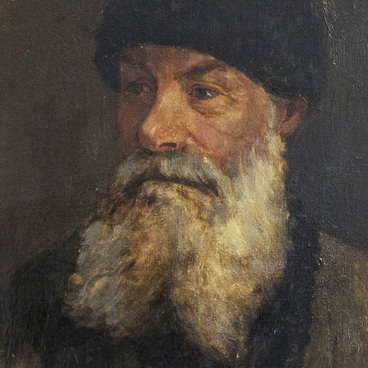Kosta Khetagurov was not only a famous writer, but also a talented artist. He painted portraits and landscapes, paintings about social issues, and even caricatures. Khetagurov’s paintings reflected the everyday life and folk culture of ordinary residents in the Caucasus Mountains.
The artist often turned to images of women and the theme of women’s fate in his works. Nine of Khetagurov’s portraits, of which five are portraits of women, have been preserved to this day. The artist’s works embodied the contradictory position of contemporary women who, on one hand, they were practically powerless in the family, yet on the other hand, they had a high authority in society. Art critics also note that Kosta usually painted real people and and even some generalized characters are given traits from his relatives and close friends.
So, in the painting ‘In an Ossetian Saklya’ in the images of three highlanders, Khetagurov painted women who familiar to him: his mother Maria, who died in the poet’s early childhood; her friend Khaira Khetagurova, and Chendze Tuaeva-Dzaparova, who raised Kosta after Maria’s death.
Women preparing Ossetian araka - an alcoholic drink made from corn or barley grains. Above the fire is a blackened boiler covered with a massive lid with a tap for the coil. To the left is a rough, wooden tub with a thick cooling mixture. A woman is sitting next to it, stirring the mixture, and from a small tap pours a thin stream of hot araki. On the wall hang a traditional Ossetian tripod and sieve.
Kosta’s picturesque style is very laconic. The artist was inspired by the works of Giotto, Caravaggio, and Bosch, as well as the surrounding environment and atmosphere of simple Ossetian villages. That is why in Khetagurov’s paintings, aspects of everyday life of his compatriots are transformed into objects of high art. In his genre paintings, Ossetians appear natural and calm. They do not pose, but rathercarry out their usual actions, perform everyday work, thinking about life. At the same time, pessimism is alien to Khetagurov’s works: his characters do not look sad and depressed. On the contrary, they stoically survive all the hardships of a difficult life in the mountains.
The artist often turned to images of women and the theme of women’s fate in his works. Nine of Khetagurov’s portraits, of which five are portraits of women, have been preserved to this day. The artist’s works embodied the contradictory position of contemporary women who, on one hand, they were practically powerless in the family, yet on the other hand, they had a high authority in society. Art critics also note that Kosta usually painted real people and and even some generalized characters are given traits from his relatives and close friends.
So, in the painting ‘In an Ossetian Saklya’ in the images of three highlanders, Khetagurov painted women who familiar to him: his mother Maria, who died in the poet’s early childhood; her friend Khaira Khetagurova, and Chendze Tuaeva-Dzaparova, who raised Kosta after Maria’s death.
Women preparing Ossetian araka - an alcoholic drink made from corn or barley grains. Above the fire is a blackened boiler covered with a massive lid with a tap for the coil. To the left is a rough, wooden tub with a thick cooling mixture. A woman is sitting next to it, stirring the mixture, and from a small tap pours a thin stream of hot araki. On the wall hang a traditional Ossetian tripod and sieve.
Kosta’s picturesque style is very laconic. The artist was inspired by the works of Giotto, Caravaggio, and Bosch, as well as the surrounding environment and atmosphere of simple Ossetian villages. That is why in Khetagurov’s paintings, aspects of everyday life of his compatriots are transformed into objects of high art. In his genre paintings, Ossetians appear natural and calm. They do not pose, but rathercarry out their usual actions, perform everyday work, thinking about life. At the same time, pessimism is alien to Khetagurov’s works: his characters do not look sad and depressed. On the contrary, they stoically survive all the hardships of a difficult life in the mountains.



